“How can I be sure in a world that’s constantly changing?” – The Rascals, 1967
My panel at the most recent Advertising Week in London focused on everyone’s favorite topic du jour, podcasting. And the favorite topic within the topic, the question of “host-read” ads versus “announcer-read” ads, dominated a lot of the conversation as usual.
The commonly-accepted narrative is well-known at this point: host-reads, by nature, should be more effective. If the Joe Rogan’s and Malcolm Gladwell’s themselves are a big reason why people tune in, the thinking goes, then having those hosts read and personalize the ads gives the pitch credibility.
As Scott Simonelli discussed the issue with Megaphone’s Ken Lagana on the latest episode of The Sonic Truth, I was reminded of another piece of historically-accepted wisdom that we’ve covered before: that the disclaimer ruins ad creative. A hallmark of certain types of car ads, pharma ads and more, the disclaimer — that speedily-read barrage of obligatory copy — hasn’t cultivated the greatest reputation. The repercussions on the radio, in particular, have, in some cases, been damaging — for example, compelling many car dealer groups to spend their ad dollars elsewhere.
Yet, in a study of auto advertising we did with Westwood One, the data tells a different story. In an analysis of consumers’ emotional response and intent to purchase a car after listening, the tier-two auto ads (with a disclaimer) proved to be some of the best-testing radio ads in the country, consistently landing in the top 20 per cent.
Does that mean that everyone should run out and start adding disclaimers to their ads? Of course not. It just means that we should take nothing for granted and figure out, objectively, what works best for a given campaign to a particular audience on a certain channel.
“The value of data — of quantifiable proof — is never more powerful than when it’s correcting a perception that’s been long-taken as a given,” stated Simonelli in the wake of the test.
The same holds true for podcast advertising. Again, host-read ads surely have unique strengths — but so do announcer-read ads. For example, certain campaigns may require an ad format that is less “tethered” to the host and can bring in different elements that yield the best creative, objectively, for a given circumstance. In the realm of creative versatility — from voice to tone, script to sound effects — the announcer-read format can shine.
The point, whether you’re talking ad format or any other variable, isn’t to just jump on one bandwagon from another. It’s for brands to find out for themselves what’s going to work best for their audiences. Some campaigns may require the power of an influencer just laying out the reasons why they love a product; others may be better suited to a pre-produced spot with an orchestral swell halfway through the ad. Some campaigns may even require both.
“The two formats should really work in tandem,” Ken states. “Ultimately, this is about brands connecting to people and hitting their goals, and the only real way to know which is going to work the best is to test.”
Looking for certainty about love in a period like the late ’60s, The Rascals were pretty much out of luck. In our own time of rapid change, data can help bring us closer to certainty — some might say even with something as complex as love. But certainty in advertising? That should be easy.
Listen to the latest episode of The Sonic Truth with Megaphone’s Ken Lagana here.

